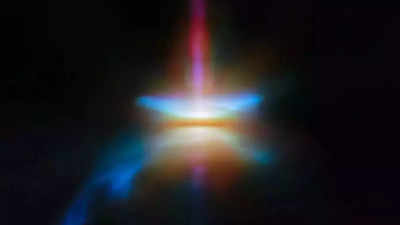The Webb Space Telescope is charged with imaging the cosmos at infrared and near-infrared wavelengths, so it should come as no surprise when it captures a familiar object in an entirely new way.
Nevertheless, we’re impressed. Webb imaged an edge-on protoplanetary disk with unerring precision, capturing the object’s wind and jets, according to an ESA press release. The image is the latest measure of Webb’s abilities, which it deploys from a region in space roughly one million miles from Earth.
The protoplanetary disk is actually a Herbig-Haro object dubbed HH 30. Such objects are glowing regions in space that contain newborn protostars. The newly formed suns spit up jets of gas and blow wind (ever heard of a farting baby?).
Seen edge-on, the protoplanetary disk shows how gas and dust are flowing away from the nascent star at the heart of the object. Edge-on views often show familiar objects in new ways—consider the Gaia spacecraft’s map of the Milky Way, based on more than three trillion observations, which allowed visual specialists to create a precise edge-on view of the galaxy. Gaia promptly retired on completion of the galactic map.
The Hubble Space Telescope previously imaged the disk, but not nearly at the same resolution (or at the same wavelengths) as Webb. Hubble still serves an important function imaging the cosmos at optical, ultraviolet, and some infrared wavelengths, but Webb is on another level.

The Webb observations of HH 30 were taken as part of a program that is determining how dust evolves in such protoplanetary disks. The Webb data was combined with the previous Hubble observations and data from the Atacama Large Millimeter/submillimeter Array, or ALMA, to see how the disk appeared across a slew of wavelengths.
But Webb’s infrared image of HH 30 is just one view the stunning space observatory took of the object; it also imaged the disk in visible, near-infrared, and mid-infrared light, as seen below. The other image—where the disk appears a thin reddish line—was taken by ALMA.

The line of color sticking out of the object’s center (both above and below it, if you look closely), are jets of material. The disk itself is the narrow, dark band of dust separating the luminous blue-green sections of the object. A gossamer blue tail issues out of the object towards the bottom-left corner of the image.
Images like this help scientists understand the extreme environment in which planets are born from the ether surrounding young stars. As Webb continues to observe such objects, we’ll better understand the ways different exoplanets form and how our own solar system—and indeed, our own world—came to be.



























































